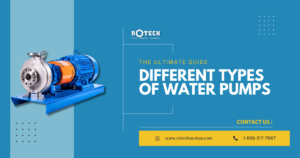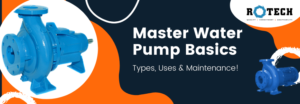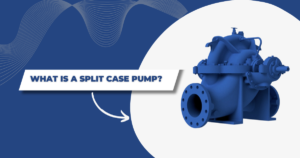End suction pumps are a type of centrifugal pump that is commonly used in a variety of applications. These pumps work by using a spinning impeller to create flow and pressure, which moves the liquid through the pump and out to the discharge outlet.
The pump consists of a housing that contains an impeller and a motor, which drives the impeller. The liquid to be pumped enters the pump through an inlet, often located at the end of the pump opposite the motor. The impeller then spins, creating a centrifugal force that pushes the liquid outward. As the liquid moves through the impeller and out of the pump, it gains velocity and pressure. The discharge outlet is typically located at the top of the pump, above the impeller. As the liquid is discharged, it creates a suction effect that helps to draw in more liquid from the inlet, continuing the flow of the pump.
Understand the Streamlined Process of It:
The process of how an end suction pump works can be broken down into the following steps in detail:
- The motor of the pump is started, typically by an electrical current or by mechanical means such as a belt or pulley system. The motor turns the impeller shaft, which is connected to the impeller.
- The liquid to be pumped enters the inlet of the pump, which is usually located at the end of the pump opposite the motor. The liquid is drawn into the impeller by the suction created as the impeller spins.
- As the impeller spins, it creates a centrifugal force that pushes the liquid outward. The impeller blades, which are angled and shaped to create the desired flow and pressure, move the liquid through the impeller and out of the pump.
- The liquid moves through the impeller and out of the pump, gaining velocity and pressure. The discharge outlet, which is typically located at the top of the pump above the impeller, releases the pressurized liquid.
- As the liquid is discharged, it creates a suction effect that helps to draw in more liquid from the inlet. This suction is caused by the pressure drop that occurs as the liquid is discharged from the pump.
- The process continues as long as the pump is running, with the impeller spinning and the liquid flowing through the pump. The speed of the impeller, the size and shape of the impeller and pump housing, and the properties of the liquid being pumped can all affect the performance of the pump.
- It is important to ensure that the pump is properly sized and designed for the specific application and to maintain the pump according to the manufacturer’s recommendations to ensure optimal performance and longevity
What Are The Various Application Of These Pumps:
End suction pumps are a type of centrifugal pump that is commonly used due to their simple design, ease of maintenance, and versatility. Some examples of the types of applications in which end suction pumps may be used include:
- Water and Wastewater Treatment: End suction pumps are commonly used in the treatment of water and wastewater to move liquids and sludge through the treatment process.
- Irrigation: End suction pumps are often used in irrigation systems to move water from a source, such as a river or well, to fields or other areas.
- Industrial processing: End suction pumps are used in a variety of industrial processing applications, such as chemical processing, pharmaceutical manufacturing, and food and beverage processing.
- HVAC: End suction pumps are used in heating, ventilation, and air conditioning (HVAC) systems to circulate water and other fluids through the system.
- Power Generation: End suction pumps are used in power generation facilities to move water and other fluids through the cooling and condensing systems.
- Marine: End suction pumps are used in the marine industry to transfer fuel, water, and other fluids on board ships and offshore platforms.
- Municipal: End suction pumps are used in municipal water and wastewater treatment plants to move water and wastewater through the treatment process.
- Agricultural: End suction pumps are used in agricultural applications, such as irrigation and livestock watering.
In addition to these applications, end suction pumps are also used in a variety of other industries and settings, including residential and commercial building systems, mining, and oil and gas production.
How to Choose the One for Your Needs?
Here are several factors to consider when selecting an end suction pump to ensure that it is appropriately sized and designed for the specific application. Some of the key factors to consider include:
- Type and Viscosity of the Liquid Being Pumped: The type and viscosity of the liquid being pumped will affect the performance of the pump. It is important to select a pump that is designed to handle the specific type of liquid being pumped and to consider the viscosity of the liquid, as higher viscosity liquids may require a pump with a more powerful motor and impeller.
- Required Flow Rate and Pressure: The flow rate and pressure requirements of the application will determine the size and capacity of the pump needed. It is important to select a pump with the appropriate flow rate and pressure capabilities for the specific application.
- Operating Environment: The operating environment of the pump, including the temperature, humidity, and presence of any abrasive or corrosive substances, should be taken into consideration when selecting a pump.
- Space Constraints: The size and layout of the space in which the pump will be installed should be taken into consideration when selecting a pump.
- Maintenance and Repair Requirements: The ease of maintenance and repair of the pump should be considered when selecting a pump to ensure that it can be easily maintained and repaired as needed.
- Cost: The cost of the pump, including the initial purchase price and ongoing maintenance and repair costs, should be taken into consideration when selecting a pump.
It is important to carefully consider these and any other relevant factors when selecting an end suction pump to ensure that it is appropriate for the specific application and will perform effectively and efficiently.
Why Buy From A Reputed Supplier Like Rotech?
- Quality: Reputed suppliers are more likely to sell pumps that are made with high-quality materials and meet industry standards. This can ensure that the pump is reliable and performs well over time.
- Expertise: Reputed suppliers typically have a team of experts who can help you select the right pump for your specific needs and application. They can also provide guidance on the installation, operation, and maintenance of the pump.
- Warranty: Reputed suppliers often offer warranties on their products, which can give you peace of mind and protect your investment.
- Service and Support: Reputed suppliers usually have a strong customer service and support team that can help you with any issues you may have with your pump.
- Reputation: Buying from a reputed supplier can give you confidence that you are dealing with a reputable company that has a track record of providing high-quality products and excellent customer service.
Overall, buying an end suction pump from a reputed supplier can provide you with a reliable, high-quality product and the support you need to ensure that it performs effectively and efficiently.
A Little About Us!
We stand by a commitment to superior quality products with on-time delivery backed by an unwavering commitment to customer service excellence. This is what our customers expect from us every day, some since 2003. Rotech Pump & Systems Inc. also offers after-sales service and maintenance, which is an important part of ensuring outstanding performance. Our dedicated team of skilled professionals is available on-site or by phone to advise, provide service support and assist you in the operation and maintenance of the products we supply.
For Rotech, customers come first!
Recent Posts

A Comprehensive Guide to Types of Water Pumps and Their Applications
Introduction Water pumps are indispensable

The Complete Guide to Water Pumps: Types, Uses, and Maintenance
Water is life, and the

Comprehensive Guide to Split Case Pumps
Split case pumps are a


